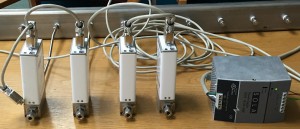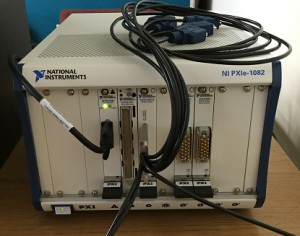 Brooks Instrument Model GF40 MFCs (qty 4) with Multi-drop Cables
Brooks Instrument Model GF40 MFCs (qty 4) with Multi-drop Cables
LabVIEW™, a National Instruments software development tool, is widely used to create software applications that monitor and control a variety of sensors and control devices. It is very common to find a laboratory, university, or a pilot manufacturing plant using one of these applications to interface with mass flow devices. LabVIEW™ software can interface with a Brooks Instrument mass flow device through different forms of data acquisition. The most popular forms of data acquisition used with Brooks Instrument mass flow devices are described below.
Analog Signal Interface
 Power Supply by National Instruments
Power Supply by National Instruments
The chances are good that LabVIEW™ software users have analog to digital I/O cards, and can run their MFCs utilizing the 0-5 volt or 4-20 mA analog signaling via LabVIEW™. This is recommended for anyone who may not be ready to move to direct digital control.
RS485 Digital Signal Interface
Brooks Instrument mass flow devices configured with the ‘S' communications option provide RS485 digital communications via the 15-pin D connector. The RS485 digital signal can be passed directly to the computer running LabVIEW™ through a serial RS485 converter. The
GF40,
GF80 and
SLA Series MFCs from Brooks Instrument can be configured with the ‘S' communications option.
- Brooks Instrument provides a free set of VI files for use with LabVIEW™ software via our website which can be loaded directly into the LabVIEW™ application, and provide the building blocks for creating a LabVIEW™ software control interface utilizing the S-Protocol digital command structure. Additionally, a Brooks LabVIEW™ DLL file is included so these building blocks can be referenced and used within a LabVIEW™ application program interface (API).
- Another possibility is to use the Brooks Instrument Smart DDE (Dynamic Data Exchange) software as an alternate tool to create links between the LabVIEW™ application and the GF40, GF80 or SLA Series flow, control, and configuration parameters. Additionally, the user can leverage Windows applications (Excel, Word, Access) and programming languages ( C++, C#, Visual Basic) and SCADA programs from suppliers such as Allesco and Millennium Systems International. No knowledge of the mass flow device S-Protocol command structure is required. With Smart DDE, the user gets direct access to the required data fields. This is not a 100% turnkey solution, but reduces the amount of coding required to communicate with and control the MFC.
DeviceNet Digital Signal Interface
GF40, GF80 and SLA devices configured for DeviceNet digital communications can also be controlled via the LabVIEW™ application. Note that this requires a National Instruments DeviceNet interface card and associated drivers and software, which provide support for developing application interfaces using LabVIEW™ software for Windows and LabVIEW™ Real-Time. The following is taken from the National Instruments website: National Instruments DeviceNet for Control interfaces are for applications that manage and control other DeviceNet devices on the network. These interfaces, offered in one-port versions for PCI and PXI, provide full master (scanner) functionality to DeviceNet networks. All NI DeviceNet interfaces include the NI-Industrial Communications for DeviceNet driver software, which features easy access to device data and streamlined explicit messaging. Use a real-time controller such as PXI and NI industrial controllers to create deterministic control applications with the NI LabVIEW Real-Time Module.
So, don't be afraid to go digital. The digital aspect of our mass flow devices include many on-board functions that work in the background and make the device superior even if the final flow signal is sent via analog signal (0-5 Vdc or 4-20 mA).